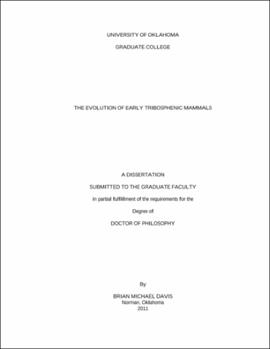| dc.contributor.advisor | Cifelli, Richard | |
| dc.creator | Davis, Brian M. | |
| dc.date.accessioned | 2019-06-07T01:03:28Z | |
| dc.date.available | 2019-06-07T01:03:28Z | |
| dc.date.issued | 2011 | |
| dc.identifier | 995999202042 | |
| dc.identifier.uri | https://hdl.handle.net/11244/320338 | |
| dc.description.abstract | The history of paleomammalogy stretches back to the beginning of paleontology as a scientific discipline; though with far less fanfare, early fossil mammals were discovered alongside the iconic dinosaurs that would capture the imagination of the world. Their small size and generally poor preservation limited the data which could be gleaned from fossil mammals, until advances in collection and study techniques in the middle of the 20th Century sparked a revolution in our understanding of mammalian character evolution. Recent fossil discoveries, most notably from poorly-sampled regions such as China and the southern continents, have led to further reevaluation of the complex nature of early mammalian evolution; in particular, the relationships between the living groups of mammals and the arrangement of the major fossil lineages have been thrown into question. | |
| dc.description.abstract | This dissertation utilizes the most recent concepts of mammalian evolution and relationships to take a fresh look at some historically and scientifically important faunas. The overall aim is to thoroughly evaluate the transition to tribospheny from amongst a cloud of lineages, each bearing a particular blend of archaic and derived dental and mandibular features. Of particular note are three groups: the Australosphenida, which have been regarded either as relatives of living insectivores or an endemic Gondwana radiation with a deep history; the Peramura, which are generally viewed as the sister-group to the clade containing most living mammals; and the Trinity therians, which have been cited as representing the earliest divergence between marsupials and placentals, and which were fundamental to our modern ideas of molar evolution. | |
| dc.description.abstract | While some new taxa are described and the contents of high-level taxa are reorganized, the principal results of these studies provide a new interpretation of character evolution in early fossil mammals. Tribosphenic mammals (the Tribosphenida) are a monophyletic group with a likely Laurasian origin, or at least an initial Laurasian radiation. The Australosphenida are structurally but not functionally similar, and represent a separate clade entirely; their relationship to monotremes is unclear. The Peramura are the best known sister-group to the Tribosphenida, and present a clear transitional morphotype. The tribosphenidan mammals from the Trinity Group illustrate the dynamic radiation and dispersal of advanced mammals that had already occurred by the Early Cretaceous; early eutherians and metatherians are represented, as well as taxa which, though curiously derived, are best left unallocated. | |
| dc.format.extent | 255 pages | |
| dc.format.medium | application.pdf | |
| dc.language | en_US | |
| dc.relation.requires | Adobe Acrobat Reader | |
| dc.subject | Mammals--Evolution | |
| dc.subject | Teeth--Evolution | |
| dc.subject | Paleontology | |
| dc.subject | Mammals, Fossil | |
| dc.title | The evolution of early tribosphenic mammals | |
| dc.type | text | |
| dc.type | document | |
| dc.thesis.degree | Ph.D. | |
| ou.group | College of Arts and Sciences::Department of Biology | |
